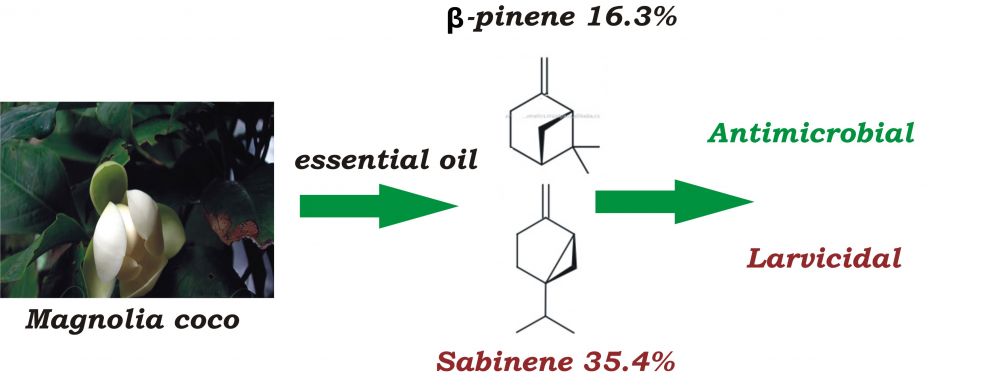JOURNAL 1541
Records of Natural Products
Year: 2020 Issue: 5 September-October
p.372 - 377
Viewed 3391 times.
GRAPHICAL ABSTRACT

ABSTRACT
The chemical constituents, antimicrobial and larvicidal activities of essential oils obtained by hydrodistillation of the leaves of Magnolia coco (Lour.) DC. are being reported. The essential oils were analyzed using Gas Chromatography-Flame Ionization Detector (GC-FID) and Gas Chromatography-Mass Spectrometry (GC-MS) while the larvicidal activity was evaluated by the protocol of the World Health Organization (WHO). The microbroth dilution assay was used for the study of antimicrobial activity. The major compounds in the oil were sabinene (35.4%) and β-pinene (16.3%). The oil exhibited 100% mortality towards Aedes albopictus at 24 h and concentrate of 50 mg/mL while maximum mortality was shown against Ae. aegypti and Culex quinquefasciatus at concentration of 100 mg/mL. The median lethal concentrations, LC50, values of 11.01, 46.46 and 87.61 mg/mL were obtained against Ae. albopictus, Ae. aegypti and Cx. quinquefasciatus respectively at 24 h. However, the LC50 values at 48 h period were 10.40, 41.98 and 53.86 mg/mL respectively. In addition, the oil exhibited antimicrobial activity against Enterococcus faecalis ATCC 299212, Staphylococcus aureus ATCC 25923, Bacillus cereus ATCC 14579 and Candida albicans ATCC 10231 with minimum inhibitory concentrations (MIC) values of 128.0, 256.0, 128.0 and 64.0 µg/mL respectively, while the IC50 values were 64.33, 128.4, 65.33 and 32.33 µg/mL respectively. These reports, the first of its kind, indicate the potentials of M. coco leaf oil as a source of antimicrobial and larvicidal agents.
KEYWORDS- Magnolia coco
- essential oil
- monoterpenes
- antimicrobial activity
- larvicidal activity